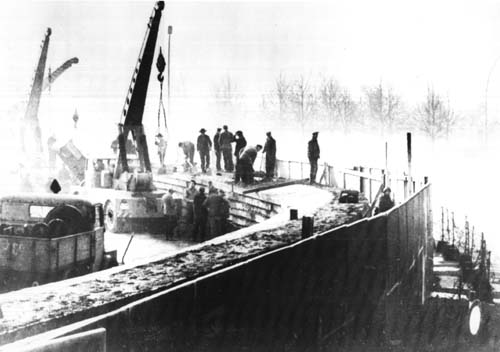The Berlin Wall
The Berlin Wall became an enduring symbol of the Cold War: a rigid barrier dividing Eastern and Western territories and ideologies. Its construction began in 1961 as the Soviets started erecting a wall that would prevent mass emigration to the West. On 13 August 1961 the border was closed between East and West Berlin.
At the end of World War Two, Germany was divided into four zones by France, Britain, America and the USSR. Berlin was also divided into four. Each victor got one sector of Germany and one sector of Berlin. Berlin itself lay in the heart of the Soviet zone.
As relations between the USSR and the other victors broke down, Berlin became a battleground between East and West. In June 1948, the Deutsche Mark was introduced in defiance of Stalin’s wishes in Berlin (see Berlin after 1945). In response, Stalin tried to force France, America and Britain out of Berlin by imposing a blockade. The Western powers were forced to airlift supplies into Berlin at a vast cost. The Soviet blockade was only lifted on 12 May 1949.

By this point Germany had rigidly divided into Western and Eastern (Soviet) blocs. In January 1947 Britain and America joined their sectors to form the Bizone. In April 1949, the French zone was joined with the Bizone to form the Trizone. In May 1949, the Trizone became the Federal Republic of Germany and in October 1949, the USSR renamed their zone the German Democratic Republic (GDR). These two blocs are more simply known as West and East Germany.
Of the two halves of the newly divided Germany, the Western side was far more prosperous. Stalin wanted to quash Germany permanently by keeping her economy weak. He also forbade Eastern European territories receiving Marshall Aid, whereas West Germany was allowed access to the aid. Eastern and Western German lifestyles became sharply demarcated. East Germans suffered from a much lower standard of living, which included a shortage of food as well as poor quality housing and lower incomes. Moreover, the Soviet Union took a quarter of East Germany’s industrial output.
There was no evidence that Eastern German predicament would improve as the 1960s beckoned, and as a result many East Germans opted to leave their bloc and head to the more prosperous Western half. In 1952, the East German government have tried to create a barrier preventing them from doing so, however this failed because Berlin - though in East Germany - had West German areas, meaning anyone looking to get from one side to the other could do so in this city.
It is reported that by 1961 approximately 3.5 million people had moved from East to West Germany (around a fifth of the country’s population), many of which were talented and highly trained individuals. This was seen a victory for the West as it showed that people wanted and were better off in a capitalist system rather than a communist one.
On 12 August 1961 Soviet authorities forced into action when the problem reached new heights; on this one day alone a record 4,000 people left for a new life in West Germany.
In the early hours of 13 August 1961, the Soviet Union took action: it used what were called "shock workers" from East Germany and Russia to close off the two sides of Berlin by putting up barbed wire fences so that people could not travel between the two. Surprised to awake and find out what had happened, the people of Berlin voiced their displeasure at what had been done but their complaints were ignored. Three days later and a more permanent concrete construction was installed, and the Berlin Wall began to take shape. Within days, West Berlin was surrounded by a wall four meters high and 111 kilometers long that also had around 300 watch towers manned by selected border guards (the ZOPO) and 50 bunkers.
The reasoning offered by the authorities was that West Berlin had become a hotbed of Western espionage. As well as keeping out the spies, the Wall was said to be a barrier to stop fascism entering East Berlin.
Even with the seemingly impervious Wall, people still attempted to leave East Berlin for the West half. In fact, 190 people were killed after being shot on site for attempting to make the journey.
On 26 June 1963, John F. Kennedy delivered his emotive ‘Ich bin ein Berliner’ speech outside the Rathaus Schöneberg, West Berlin. He said the following about the Berlin wall:
“While the wall is the most obvious and vivid demonstration of the failures of. the Communist system, for all the world to see, we take no satisfaction in it, for it is... an offense not only against history but an offense against humanity, separating families, dividing husbands and wives and brothers and sisters, and dividing a people who wish to be joined together. What is true of this city is true of Germany—real, lasting peace in Europe can never be assured as long as one German out of four is denied the elementary right of free men, and that is to make a free choice.”
MLA Citation/Reference
"The Berlin Wall". HistoryLearning.com. 2025. Web.
